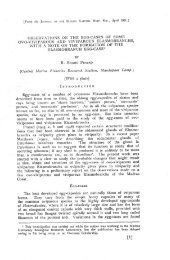PDF - Eprints@CMFRI
PDF - Eprints@CMFRI
PDF - Eprints@CMFRI
You also want an ePaper? Increase the reach of your titles
YUMPU automatically turns print PDFs into web optimized ePapers that Google loves.
171<br />
Prof. FRICKE with his submersible "Geo" collected at [WO places a remarkable Dendropbyllia which<br />
we cannot identify unequivocally and which we group with D. minuscula. It could , however , also be a<br />
deep-water ecomorph of another Dendropbyllia species. The branch lets collected are fragments of colonies<br />
30 ro 40 cm large , and clearly belong ro two different forms.<br />
(1) The branchlets collected at Sharm esh Sheikh at a depth of 126 m are slender. The daughter<br />
corallites are up ro 8 mm long, relatively despersed and more or less on the same plane. The costae of the<br />
corallites and branchlets, on which they are located, are narrow and feature a series of fine teeth.<br />
(2) In contrast, the specimens collected near Eilat in a depth of 150 m are more co mpact, the daughter<br />
corallites are closer rogether and are arranged all around the branch, measuring up ro 5 mm only. The<br />
costae of the corallites and branchlets are irregular. A dominant feature are the furrows separating the<br />
costae with numerous short or elongated perforations.<br />
The calices of both for ms measure 3 ro 4.5 mm in diameter, are slightly oval and occasionally somewhat<br />
hexagonal. The first three septa cycles are complete, the septa of the second cycle relatively short,<br />
the fourth and fifth cycles are incomplete.<br />
Material :<br />
Gulf of Aqaba : HLM Fri 37- 1 (Eilat, Aquarium, 150 m).<br />
Northern R. S.: HLM Fri 92- 3 (Sharm esh Sheikh, 126 m).<br />
Dis t ri but io n : Red Sea; Ceylon; Ke i Isis. (Banda Sea).<br />
Rem ark s : This is the first time that this species has been recorded in the Red Sea.<br />
Dr. ZIBROWIUS has ki ndly shown us some specimens of an unidentified Dendropbyllia from South<br />
Africa, very similar ro ours and perhaps of the same species. But further investigations will be required<br />
ro clarify the relationship of all these Dendropbytlia specimens.<br />
Dendropbyllia arbuscula v. d . HORST, 1922<br />
(Plate 40. Figs. 1- 3)<br />
DendrophyliiD arbuscula 1922a. v. d. HORST, lOS ; pI. 8/6 (Type local ity: Kei Islands and Dammer Island . Banda Sea).<br />
1968, EGUCHI, CSS , pl. C2I IS, Il.<br />
1974. SCHEER & PILLAI . 64, pI. 29/4, S.<br />
1976, PILLAI & SCHEER, 7J.<br />
The present specimens are all tufted dendroid colonies with corallites radiating from a central stem.<br />
Maximum height 3.5 cm . Corallites, when fully formed , measure 7 to 8 mm in diameter at the rop, with<br />
a maximum height of 15 mm from the stem. Adult ones feature small buds at their sides. Depth of calices<br />
5 ro 6 mm. Wall very thin. Septa in four complete cycles with a set of the fifth, arranged according ro<br />
POURTAUi s plan. The first two cycles join the columella. Septa of the third cycle are short and mostly<br />
free . Those of the fifth link ro the fourth , and the latter in turn form pairs and unite with the columella.<br />
Septa of the first two cycles are serrated. Septa with perforations. Columella trabecular, projecting. Intercostal<br />
spaces thinner than the costae.<br />
Material:<br />
Gulf of Suez: jerus. SLR 856-3 (Et Tur).<br />
Gulf of Aqaba: j erus. SLR 1384-2 (Wadi Treibe).<br />
T. Aviv NS 1368- 1, 2, E52123 (Eilat).<br />
Northern R. S.: T. Aviv S 5930 (Ras Muhammad ).<br />
HLM X2 : 3- 48 (1, 2) (Gubal lsl.) ; 5- 2 (Ghardaqa).<br />
Cemral R. S.: HLM X2 : 7-1 (Mayetib Isl.).<br />
Dis t rib uti 0 n : Red Sea ; Maldives; icobar Isis.; East Indies; japan.<br />
Dendropbyllia borsti GARD INER and WAUGH , 1939<br />
(Plate 39, Figs. 11 ,12)<br />
Dndropbyllia horsti 1939. GARDINER & WAUGH, 237 ; pI. 21S t 6 (Type locality: Ari Atoll, Maldives).<br />
23 Zoologica, I H
















